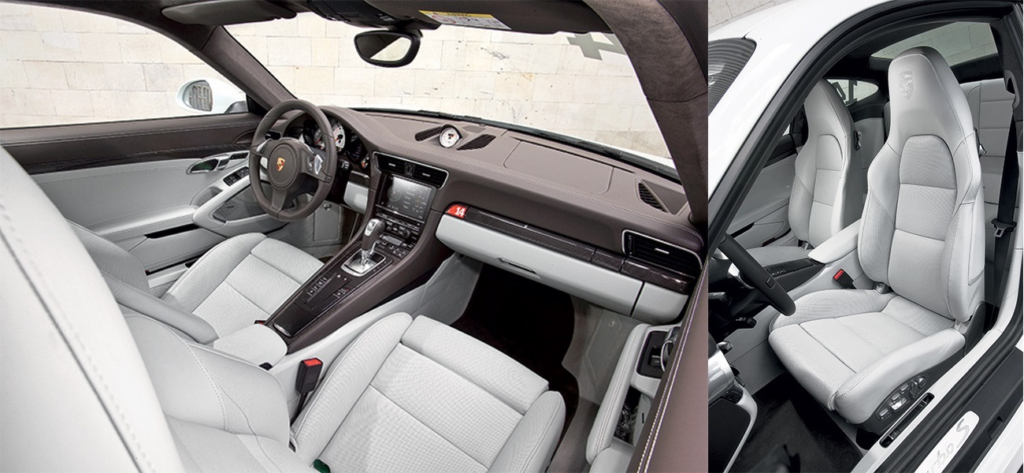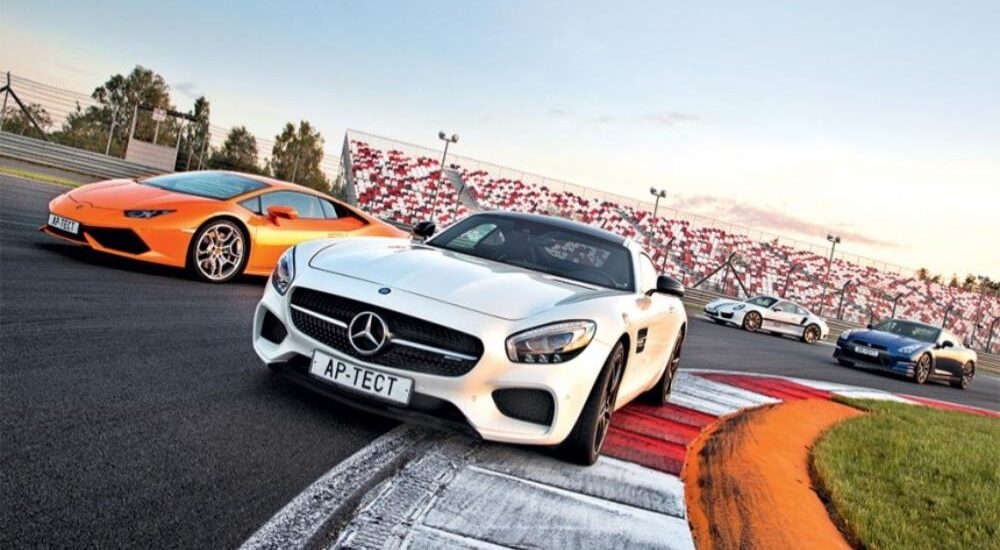Gathering these cars together is like assembling a cast of stars – each a legend in the supercar world. The Lamborghini Huracan, with its dazzling appearance, the luxurious Mercedes-AMG GT S, the classic Porsche 911 Turbo S, and the mighty Nissan GT-R are all contenders for the best performance.

Speed of Cars on the Moscow Raceway Track (FIM Configuration) According to VBox Sport GPS Receiver
Nissan GT-R
0—250 km/h: 20,8 c
Leap Time: 1 min 52,624 s
The Nissan GT-R starts with an impressive price-to-performance ratio. Its 3.8-liter V6 biturbo engine boasts 540 horsepower, sprinting to 100 km/h in just 2.8 seconds. Despite some shortcomings like noise insulation, the GT-R offers an exhilarating experience for its price.


The festive shade of the wedding dress suited the brutal interior of the Nissan well. The light leather is more pleasant to the touch than the black. The seat is softer than the others, with minimal adjustments, but still quite comfortable to sit in.

De jure, the GT-R offers nine combinations of chassis settings, but de facto there are seven. In the case of the power unit, you use two: the restrained Save position is only suitable for the return lap to the pits, and turning off the stabilization system completely is prohibited by the warranty conditions.

The six-speed automated transmission BorgWarner, even in good condition, is a weak point of the GT-R. The shifts are long, and in race mode, sometimes with unpleasant jolts. There’s no honest manual mode in the Nissan: the robot still shifts up at maximum revs.

In the back of the Nissan, there’s more headroom than in the Porsche, but to sit “with legs,” the front passenger needs to be cramped more.

Nissan is not only the heaviest in the group but also has the most loaded front: almost 55% of the weight is on the front wheels, whereas the Mercedes has only 47.6%.

Such a trunk finish in a car worth five million rubles is not pleasing. On the other hand, it’s a fight against excess weight…

Porsche 911 Turbo S
0—250 km/h: 18,3s
Leap time: 1min 48,081s
Next, the Porsche 911 Turbo S, a standard-bearer in the supercar world, impresses with its 560 horsepower engine, achieving 100 km/h in 3.5 seconds and topping nearly 316 km/h. However, its stiff suspension and noise levels might deter some.


The interiors of the base Carrera and the twice more expensive 911 Turbo S are almost indistinguishable. Seats with a multitude of adjustments can be swapped for lightweight buckets at no extra charge.

There’s no need to teach the PDK box to shift gears, but it would be nice to increase the gears by pulling towards you, not the other way around.

The Sport and Sport Plus buttons call up the corresponding settings for the power unit and suspension. The PDCC system (Porsche Dynamic Chassis Control) activates active stabilizers, thanks to which the Turbo 5 seems not to roll or squat during braking. At the top right is the button for the PAA (Porsche Active Aerodynamics) system, which extends the rear wing and inflates the spoiler under the bumper.

You can joke about the functionality of the Porsche’s rear seats, but it is more spacious than it may seem.

The Porsche 911 Turbo’s engine pleases neither the eye (all 991 series coupes have only a pair of fans under the hood) nor the ear: the turbocharged flat engine is unmusical.

Lamborghini Huracan
0—250 km/h: 17,3s
Leap Time: 1min 50,380s
Instead of the high-revving roar of a sports bike’s V10, in Lamborghini we have the rumble and bubbling of a V8 with a pair of turbochargers. At idle, it emits sound in pulses, reminiscent of a classic Harley-Davidson. The rear-wheel drive and powerful electronically controlled limited-slip differential, coupled with a fully disableable stabilization system, easily turn the rear tires into smoke. And yet, the AMG GT S is not the king of drifting: the AMG C 63 sedan does it with more ease.

To be happy behind the wheel of a Lamborghini, you don’t need to go to the track: the Huracan is magnificent on ordinary roads.

Inside the Lamborghini, everything is still unusual, but nothing falls off: the quality is finally on point. The seat is very stiff and lacks proper side support — only the grippy suede lining saves you in the corners.

Press. Olio, Temp. Olio, Batteria, a row of switches. Although the Huracan technically repeats the Audi R8, the mood behind its wheel is 100% Italian.

This car is like a motorcycle, not only with its insane acceleration but even with the turn signal control.

The slider on the vertical spoke of the steering wheel changes the mood from the road mode Strada to the racing Corsa in two clicks: adjusting the settings of the power unit, suspension, and the level of effort on the steering wheel.

On the ramp of the central console – a mix of original elements and switches from various Audi cars.

To start the engine, you need to lift the red cap over the button. Below is the claw for engaging reverse in the robotized LDF (Lamborghini Doppia Frizione) gearbox. There is no Drive button – to select first gear, you need to pull the right paddle.


The Lamborghini’s information screen doesn’t boast the highest resolution, but its graphics are impressive. It allows swapping the speedometer and tachometer positions or displaying secondary electronic menus, including the navigation map.

At speeds up to 70 km/h, the Huracan can tiptoe: the nose can be raised by four centimeters, for example, when passing artificial irregularities.

Who else but Lamborghini would prominently display the cylinder firing order?

Mercedes-AMG GT S
0—250 km/h: 20,5 s
Leap time: 1 min 52,090 s
The robust sound of the Mercedes engine turns it into a drum machine, and when the stabilization system is off, it becomes a smoke machine.


The Mercedes has nozzles. The interior is studded with round vents and switches. The color scheme in this car is a matter of taste, but the feeling of the cockpit is 100%. Largely due to the ultra-low seating position in the excellent seats with adjustable backrest width and cushion.

The instruments are overly colorful. In practice, the central display readings are most used: initially monitoring oil temperature, then shifting to the digital speedometer after warming up.

The paddles in the AMG GT S are fixed to the steering wheel and more convenient than the stationary ones in Lamborghini and Nissan. The Getrag automated gearbox joystick is positioned too far back.


Under Mercedes’ enormous hood lies a 4.0-liter V8 engine, shifted within the wheelbase limits. Two turbochargers nestled in the V of the engine block create a heavily loaded thermal regime – making the AMG GT S’s cooling fans work louder and longer than others after turning off the ignition.

The main switch on the massive central tunnel controls the car’s settings. There are combinations of modes for the gearbox, suspension, stabilization system, and exhaust sound for all three supercars. All positions are beautifully and clearly displayed on the screen. Note that there’s no separate tab for steering effort selection: like in Porsche and Nissan, it remains consistent across all modes.


Comparative Analysis
The Porsche 911 Turbo S distinguishes itself with its dynamic prowess and emotional appeal, showcasing precision akin to running on rails and exhilarating acceleration. However, its sensitivity to tire choice affects its performance on different terrains. Notable for its robust low-end power, the 911 Turbo S provides exceptional grip with original tires and a braking system that allows for later braking than other cars, enhancing its competitive edge. Despite its stability issues at speeds over 280 km/h, its braking remains reliable.

Porsche 911 Turbo S
The Lamborghini Huracan, a notable step up from the Gallardo, impresses with its engine and transmission upgrades. Its Formula 1-like sound and track-friendly behavior contrast with the slightly lacking initial grip of its brakes. The all-wheel drive’s contribution to its performance is debatable, but the Huracan remains a fierce yet friendly performer, with powerful engine and stiff suspension leading to distinct driving dynamics. Its ABS system’s harsh engagement complicates trajectory planning, yet with acclimatization, its performance, including stability at speeds up to 325 km/h, is remarkable.

Lamborghini Huracan
The Mercedes-AMG GT S presents a simpler, more accessible experience compared to the SLS, with a well-balanced chassis and a slightly oversteering tendency. The stabilization system and brakes need fine-tuning for consistency. Emotionally, the car stands out with its powerful sound and luxurious interior. Ready for the racetrack, it maintains balance and prevents overheating even in challenging conditions.

Mercedes-AMG GT S
The Nissan GT-R, known for its powerful engine and comfortable suspension, offers confident handling but diverges from its former image as a super-stable, fast vehicle. Its driving experience is unique, particularly with the non-disconnectable stabilization system. Despite its impressive stability at high speeds, the GT-R faces challenges with brake overheating and slower gearbox shifting, affecting its sporty character. Its performance in drag racing contrasts with its somewhat lacking acceleration in standard models.

Nissan GT-R
Stability and Handling in Emergency Situations

The site of the complex of special roads of the test site is not the surface of a racing track: on old and dusty asphalt the advantages of grippy supercar tires are neutralized. And in the tight corridors of the “Turn” and “Rearrangement with braking” maneuvers, the main role is played by the settings of the ABS and stabilization systems.
Lamborghini Huracan showcased excellent stability at 75 km/h without slipping and a minimal four-wheel slide at 77.5 km/h. Its braking maneuver achieved 29.8 meters, but its ABS was rough, slightly reducing deceleration during lane changes.
Porsche 911 Turbo S displayed neutral steering with manageable speeds up to 75 km/h, drifting slightly at 77.5 km/h. It excelled in braking, stopping within 30.5 meters consistently.
Mercedes’ ESP allowed a minor deviation when understeering at 72.5 km/h, and its rear-axle seating required early steering to navigate tight cone corridors. Its braking distance was slightly inferior at 32.4 meters, with a tendency for rear-axle slippage causing 1.7 meters of variation.
Nissan, being heavier and with stricter electronics, handled well at lower speeds but began to drift and clip cones at 75 km/h. It showed similar braking performance to Mercedes but with a slightly larger variation of two meters.

Each of these vehicles brings its own set of strengths and challenges to the table, offering a diverse range of high-performance experiences for enthusiasts.
Photo: Stepan Schumacher
Expert group: Andrey Mokhov | Ivan Shadrichev | Roman Cherny | Yaroslav Tsyplenkov
This is a translation. You can read an original article here: Lamborghini Huracan, Mercedes-AMG GT S, Porsche 911 Turbo S или Nissan GT-R?

Published January 25, 2024 • 9m to read





